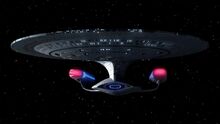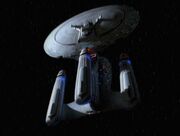| STARSHIP CLASS | |
|---|---|
| Galaxy-class | |

| |
| Affiliation: | Federation; Starfleet |
| Type: | battleship; explorer |
| Service period: | 2357-25th century |
| Dimensions | |
| Length: | 642.51 meters |
| Width: | 463.73 meters |
| Height: | 195.26 meters |
| Mass: | 4,500,000 metric tons |
| Specifications | |
| Decks: | 42 |
| Crew: | 1,012 standard); 200 (visiting); 15,000 (max. capacity) |
| Maximum speed: | warp 9.6 for 12 hours; warp 9.8 in emergencies; warp 9.9 for 12 hours (refit) |
| Cruising speed: | warp 6 |
| Armaments: | 12/14 type-X phaser arrays; 3 torpedo launchers |
| Defences: | Deflector shields |
| Auxiliary craft: | 4 workbees; 8 Federation shuttlecraft; 8 shuttlepods; 1 captain's yacht |

| |
The Galaxy-class is a type of starship built by Starfleet from the mid 24th century into the 25th century. It was intended to primarily be a ship of exploration, but is also extremely heavily armed. This class of vessel is one of the largest and most powerful ever constructed by Starfleet
History
The Galaxy-class began development in the year 2343 and has the dubious distinction of having the longest design, development, and construction period of any class in Starfleet history- delayed for a further year due to attempted sabotage by the Manraloth Giriaenn that was only just exposed by Lieutenant Data-, with the prototype USS Galaxy finally launching in 2357 and its first two sister ships the ever-famous Federation flagship USS Enterprise-D and USS Yamato following six years later in 2363.
During the initial planning board at Starfleet Operations, Admiral Carstairs would often describe the vessel's strength as a deterrent against aggression by other powers. In stark contrast, Commodore Santin was a vocal critic of the new design, fearing that fielding a ship with such destructive capabilities might serve as a provocation to the Federation's enemies.
Initially conceived as a class of twelve ships, once the design was finalized it was decided that only six ships would be completed, with construction on the other six halted once their frameworks were finished. The six spaceframes were then broken down into smaller segments and transported by cargo carrier to remote sites throughout the Federation, held in reserve in case a later emergency necessitated their completion.
The emergency came sooner than anyone could have realized, with the loss of 39 starships to the Borg at the Battle of Wolf 359 in early 2367. As a result of the battle, Starfleet immediately launched a massive shipbuilding and design program, which also saw the remaining six Galaxy-class spaceframes pulled from storage and completed in addition to many more constructed from scratch in an attempt to bolster the fleet's strength. While the expected Borg invasion did not come as imminently as was expected, during that time the Federation did find itself engaged in a war with another opponent: the Dominion. In 2370, the USS Odyssey became the first casualty of Dominion aggression when it was rammed by a Jem'Hadar fighter, destroying the ship. Galaxy-class ships went on to play a major part in the Dominion War a few years later, participating in numerous engagements.

Aft view of a Galaxy class starship
In an effort to get more ships into service, many of the existing Galaxy-class spaceframes were outfitted with additional weapons and minimal crew accommodations to decrease their construction time, leaving the yards with nearly 65 percent of their internal volume empty.
Galaxy class starships continued being produced into the 25th century, continuously being upgraded with more advanced technology.

Advanced modification of the Galaxy-class
Since the spaceframe was designed with a hundred-year lifespan in mind, the Galaxy-class will likely remain in service for years, if not decades, to come. In a possible future created by Q, the USS Enterprise was refitted with an additional warp nacelle and additional phaser arrays. The USS Venture was later modified to mount two additional phaser arrays on its warp nacelles.
By the year 2409, the Galaxy-class saw sub-class born out of the necessity with the eruption of another Federation-Klingon War. Modeled after the refitted Enterprise from Q's created future, this modified Galaxy-class would be known as the Galaxy-X class.
Features
The Galaxy-class did not present any particular technological revolution, but was the culmination of several Starfleet technologies to date. One of the largest classes of ships constructed by Starfleet, it accommodated not just the crew but also their families and other civilians in spacious quarters, providing extensive recreational areas including the latest in holodeck technology. Intended primarily as a ship of exploration, its size and facilities allowed unsupported missions of up to a decade if necessary. In addition, it could effectively serve as a mobile starbase in the Federation's outlying territories, showing the flag and defending against encroachment by hostile powers.
One of the main technological breakthroughs that the class did employ was the facility for routine saucer separation. While the separation option had been available in a number of previous starship classes, it had always been necessary to utilize starbase facilities to reconnect the severed parts of the ship. The Galaxy-class was the first design that was capable of separating and reconnecting at will, allowing a large proportion of the crew to escape hostile situations.
Galaxy-class starships also featured a large lounge and bar area in the most forward area of the ship, where the crew can relax and get something to eat. Located on deck 10, on the USS Enterprise-D this area was named Ten-Forward, whereas on the USS Challenger this area was known as Shuttlebay Four, until it was renamed to Nelson's.
Known ships
- USS Agrippa
- USS Allegheny
- USS Andromeda
- USS Argo
- USS Asgard (destroyed, 2375)
- USS Berry
- USS Bolivar
- USS Bonhomme Richard
- USS Breedlove
- USS C. Lewis
- USS Challenger
- USS Cheyenne
- USS Citadel
- USS Constellation
- USS Constitution
- USS Dauntless
- USS Defiance
- USS Dominance
- USS Eagle
- USS El Dorado
- USS Endeavor
- USS Enterprise (NCC-1701-D) (destroyed, 2371)
- USS Essex
- USS Excalibur (NCC-26517-A)
- USS Exeter
- USS Explorer (NCC-4589)
- USS Farragut
- USS Formidable
- USS Frontier
- USS Galaxy
- USS Geronimo
- USS Goodman
- USS Hedderjin
- USS Hood
- USS Hornet
- USS Idaho
- USS Jefferies
- USS Jubei
- USS Kongo
- USS Krieger
- USS Lafeyette
- USS Lexington
- USS Madison
- USS Magellan
- USS Malevolent
- USS Merrimac
- USS Monitor (destroyed, 2377)
- USS Mukaikubo
- USS Odyssey (destroyed, 2370)
- USS Oraidhe (recommissioned, 2371)
- USS Oregon
- USS Pequod
- USS Perseus
- USS Persia
- USS Renown
- USS Republic
- USS Reverent
- USS Robinson (NCC-71842)
- USS Rylander
- USS San Francisco
- USS Saratoga
- USS Scimitar
- USS Sequoia
- USS Sorak
- USS Taylor
- USS Tori
- USS Trident
- USS Trinculo
- USS Ulysses
- USS Valhalla
- USS Valiant
- USS Venture
- USS Victory
- USS Vindictive
- USS Wasp
- USS Yamato (destroyed, 2365)
- USS Yamato
- USS Yorktown
- USS Zhukov
- USS Dauntless (NCC-71879)
- USS Intrepid (NCC-724656) (destroyed, 2378)
- USS McIlhatten (NCC-73582)
- USS Kansas
- USS Iowa (NCC-5159-A)
- USS Yorktown (NCC-1588)
- USS Pegasus (NCC-53958)